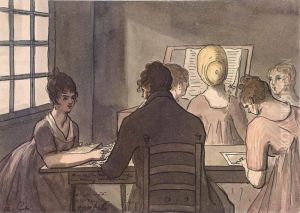Christiaan Andriessen Paintings
Christiaan Andriessen was a Dutch artist born in Amsterdam on February 14, 1775, into an artistic family. His father, Jurriaan Andriessen (1742–1819), was a well-known decorative painter and teacher, which provided Christiaan with an environment rich in artistic influence from an early age. He initially trained under his father before furthering his studies at the Amsterdam Drawing Academy, where he honed his skills in drawing and painting. Christiaan Andriessen is particularly noted for his work in watercolors and his contributions as a draughtsman.
Unlike many artists of his time who focused on grand historical or mythological themes, Andriessen found his niche in capturing the everyday life of Amsterdam and its inhabitants during the late 18th and early 19th centuries. He is best known for his detailed diary sketches, which he diligently kept from 1805 to 1808. These sketches provide a unique window into the daily life, architecture, and social conditions of Amsterdam during this period. His work is characterized by its meticulous detail, sensitivity to light, and the candid portrayal of his subjects, ranging from intimate family scenes to lively street views.
Beyond his sketches, Andriessen also engaged in creating more formal works of art, including portraits and landscape paintings. However, it is his diary sketches that have cemented his legacy, offering invaluable insights into the cultural and historical context of the Netherlands in the early 19th century. Despite his contributions to Dutch art and the historical value of his work, Christiaan Andriessen remained relatively obscure until more recent times when art historians began to appreciate the importance of his detailed observations of everyday life.
Christiaan Andriessen passed away on December 17, 1846, in Amsterdam. Today, his works are preserved in various Dutch museums, including the Amsterdam Museum, where they continue to attract interest for their historical significance and artistic merit. Through his detailed and candid portrayals of 19th-century Amsterdam, Andriessen has provided future generations with a vivid snapshot of his time, making him a noteworthy figure in the history of Dutch art.
